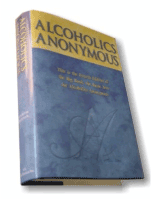Big Book
 When Bill Wilson (with the help of Sam Shoemaker) finished what would become the central book for Alcoholics Anonymous in 1938, he never imagined it would have the impact it still has in addiction recovery. Known as “The Big Book,” it is in it’s fourth edition and is widely circulated through out the world. The Big Book holds within it the central thesis and ideas of Alcohol Anonymous and the 12 Step approach. It begins with the story of Bill W., anonymously written as is the approach with the 12 Steps in all areas. Most addicts feel that The Big Book is a powerful component to the recovery process and treat it as a sort of “Bible” for addiction recovery.
When Bill Wilson (with the help of Sam Shoemaker) finished what would become the central book for Alcoholics Anonymous in 1938, he never imagined it would have the impact it still has in addiction recovery. Known as “The Big Book,” it is in it’s fourth edition and is widely circulated through out the world. The Big Book holds within it the central thesis and ideas of Alcohol Anonymous and the 12 Step approach. It begins with the story of Bill W., anonymously written as is the approach with the 12 Steps in all areas. Most addicts feel that The Big Book is a powerful component to the recovery process and treat it as a sort of “Bible” for addiction recovery.
Perhaps some of the more important features of the newer editions are the appendixes, which hold valuable information and points of clarity on the role of spirituality and addiction recovery.
The most powerful part of The Big Book is that no matter how far reaching Alcoholics Anonymous has become it remains an anonymous work, completed and presented with humility.
“While our literature has preserved the integrity of the A.A. message, sweeping changes in society as a whole are reflected in new customs and practices within the Fellowship. Taking advantage of technological advances, for example, A.A. members with computers can participate in meetings online, sharing with fellow alcoholics across the country or around the world. In any meeting, anywhere, A.A.’s share experience, strength, and hope with each other, in order to stay sober and help other alcoholics. Modem-to-modem or face-to-face, A.A.’s speak the language of the heart in all its power and simplicity.” — Anonymously Written Forward to The Big Book’s Fourth Edition.